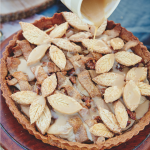Healthy Food
Eat the season: autumn fruits and nuts
Nothing brightens up an autumn walk on a chilly, overcast day better than reaping a colourful harvest of antioxidant-rich berries, late-season fruits and nutritious nuts from orchards and hedgerows. Discover some of our favourite foraged treats that bring a whole new meaning to ‘fall by the wayside’…
Quince
 Introduced to Britain in the 1500s, this ‘yellow pear’ has long been valued for its fragrant flesh (once used as a room deodoriser), which turns red on cooking. Containing a good dose of vitamin C, the fruit is best left to mellow for eight weeks in storage before being transformed into a dulce de membrillo – a rich, sweet paste that beautifully lifts pungent cheese when served on a cracker.
Introduced to Britain in the 1500s, this ‘yellow pear’ has long been valued for its fragrant flesh (once used as a room deodoriser), which turns red on cooking. Containing a good dose of vitamin C, the fruit is best left to mellow for eight weeks in storage before being transformed into a dulce de membrillo – a rich, sweet paste that beautifully lifts pungent cheese when served on a cracker.
Apricot
 These velvety globes come in golden-orange, white, black or pink, but all have a sweet and musky aroma and flavour – and are high in heart-heathy potassium. UK-grown specimens, which spend more time on the tree than in transit, avoid the woolly texture that can befall their imported cousins. For added sweetness, we absolutely love them served in this autumnal apricot frangipane – a delicious dessert or truly decadent weekend breakfast the morning after the night before.
These velvety globes come in golden-orange, white, black or pink, but all have a sweet and musky aroma and flavour – and are high in heart-heathy potassium. UK-grown specimens, which spend more time on the tree than in transit, avoid the woolly texture that can befall their imported cousins. For added sweetness, we absolutely love them served in this autumnal apricot frangipane – a delicious dessert or truly decadent weekend breakfast the morning after the night before.
Blackberry
 Most of us have experienced the tell-tale stains from blackberry picking, but did you know the tannin-rich leaves are also a balm for those thorny wounds? The bumpy purple-black drupelets, ripe when plucked easily from the stem, are powerful disease fighters, with one of the highest antioxidant levels of all fruit. We love them served whole in a salad or preserved in a jam to enjoy for seasons to come – read a selection of our favourite blackberry recipes here.
Most of us have experienced the tell-tale stains from blackberry picking, but did you know the tannin-rich leaves are also a balm for those thorny wounds? The bumpy purple-black drupelets, ripe when plucked easily from the stem, are powerful disease fighters, with one of the highest antioxidant levels of all fruit. We love them served whole in a salad or preserved in a jam to enjoy for seasons to come – read a selection of our favourite blackberry recipes here.
Fig
 Chiefly in season in September and October in the UK, figs are high in potassium and calcium, so are excellent for skeletal strength and regulating blood pressure. They’re also great for the digestive system due to their levels of insoluble fibre – and the pectin they contain collects the ‘bad’ LDL form of cholesterol as it passes through our body. They look beautiful when topping a simple honey cupcake with a tangy spoonful of soft goat’s cheese.
Chiefly in season in September and October in the UK, figs are high in potassium and calcium, so are excellent for skeletal strength and regulating blood pressure. They’re also great for the digestive system due to their levels of insoluble fibre – and the pectin they contain collects the ‘bad’ LDL form of cholesterol as it passes through our body. They look beautiful when topping a simple honey cupcake with a tangy spoonful of soft goat’s cheese.
Walnut
 Another indigenous British nut, these knobbly specimens not only look like little brains, but thanks to the neuroprotective properties of their vitamin E, melatonin and omega fatty acids, they protect our brains too! For a truly autumnal treat, enjoy them in a hot caramelised apple and walnut lattice pie or for something totally different, blitz them with garlic, butter and parmesan for a simple savoury pasta sauce.
Another indigenous British nut, these knobbly specimens not only look like little brains, but thanks to the neuroprotective properties of their vitamin E, melatonin and omega fatty acids, they protect our brains too! For a truly autumnal treat, enjoy them in a hot caramelised apple and walnut lattice pie or for something totally different, blitz them with garlic, butter and parmesan for a simple savoury pasta sauce.
Hazelnut
 The humble hazelnut, or cobnut, has a small carbon footprint (harvested in Kent in-the-green from mid August, and with shells form October). Despite their diminutive size, they are big in monounsaturated fat and folate, which help maintain normal homocysteine levels for heart health. Top your toast with a healthy hazelnut and chocolate butter or in a classic side dish with Brussels sprouts.
The humble hazelnut, or cobnut, has a small carbon footprint (harvested in Kent in-the-green from mid August, and with shells form October). Despite their diminutive size, they are big in monounsaturated fat and folate, which help maintain normal homocysteine levels for heart health. Top your toast with a healthy hazelnut and chocolate butter or in a classic side dish with Brussels sprouts.





